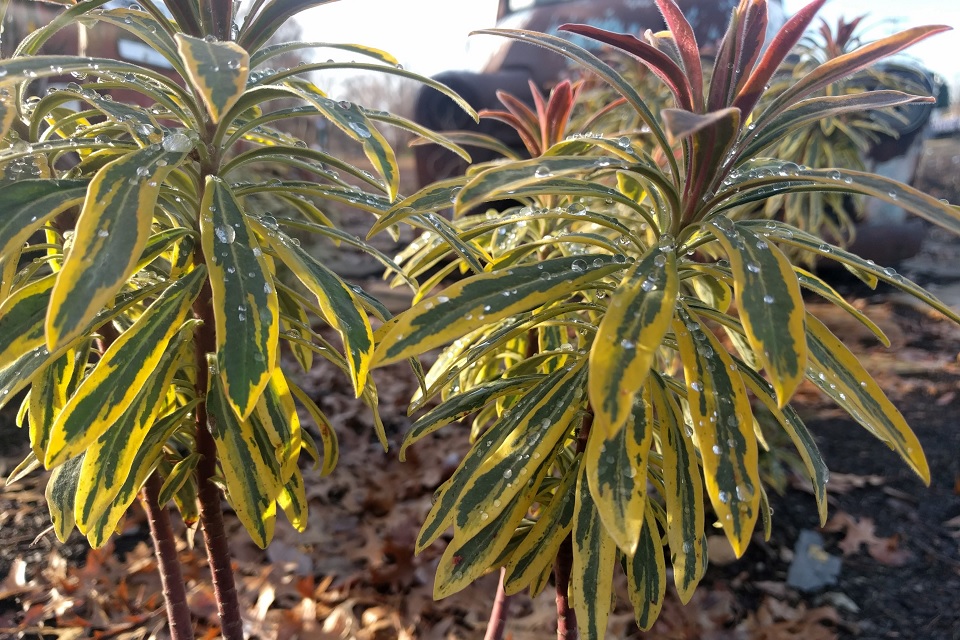
These Fuss-free, Deer-resistant Plants Add Interest to the Landscape
Submitted by Alexandria Smith, UT Gardens, Knoxville, plant collections curator and horticulturist
Euphorbia, often called spurge, belongs to the Euphorbiaceae family, a very diverse group of flowering plants with more than 2,100 species. The genus is represented all over the world and can vary dramatically in appearance, with some species having forms that look like small cacti and others that become large, long-lived trees.
In Tennessee, several herbaceous euphorbias are perennials. Historically, the milky latex often found in the stems of euphorbias has been used in traditional medicine to treat skin ulcers, warts and intestinal parasites. However, protective gloves should be worn while handling spurge as the latex can sometimes be an extreme irritant to the skin and eyes.
Several species and cultivated varieties are listed below. These are available to gardeners and are valued for their year-round foliage color and unique flower interest. Varying climates across the state can affect durability, so be sure to check with the UT Gardens site in your region to see which specific varieties have performed well in your area.
E. corollata is native to the United States and can be seen growing along our roadsides. This underutilized native is grown more for the baby’s breath-like blooms that start in late summer and continue into early fall. While not as cultivated as other species, the ‘Carolina Snow’ selection boasts showy blooms proving why this tough native is worthy of a spot in the garden. Both E. amygdaloides and E. characias are native to Europe, and both species, as well as hybrids between the two, are largely responsible for the cultivars available today.
E. x martinii ‘Ascot Rainbow’ is highly sought after and for good reason. This hybrid features variegated foliage in shades of greens and yellows, with new emerging foliage tinged with red hues. Foliage also has red and orange hues during fall and winter months.
E. characias ‘Tasmanian Tiger’ is another popular cultivar, with green leaves and striking white variegation. When viewing from a distance, this cultivar almost looks completely white to silver.
E. amygdaloides ‘Waleuphglo’, also sold as E. amygdaloides ‘Ruby Glow’, is a wonderful selection that has bright ruby red spring foliage that matures to a dark purple-black color and has a more compact habit than other cultivars.
These ranges of color make euphorbia fun to pair with other annuals and perennials for striking color combinations. While these cultivars look wonderful during spring and summer, their evergreen foliage is outstanding during dreary months. Flowers appear during late spring and into early summer with each stem topped by a thick, bottlebrush-like inflorescence. Bloom colors range from shades of yellows to greens and should be removed once spent to avoid reseeding. Their size typically ranges from one to three feet tall and wide, making these perfect to tuck into mixed borders, rock gardens and containers.
Spurge likes to be planted in full sun and in very well-drained soils. They will tolerate a little shade, but tend to get leggy and look unkempt. Once established, they are fairly drought tolerant but appreciate moisture during the hot summer months. Along with being a fuss-free addition to the garden, they are also deer resistant.
At the UT Gardens, Knoxville, we have E. amygdaloides ‘Waleuphglo’ featured in containers around our Children’s Garden and E. x martinii ‘Ascot Rainbow’ surrounded by mixed perennials in our popular truck bed. UT Gardens, Crossville, also has Waleuphglo located near the flag pole in the Americana Garden.
The UT Gardens includes plant collections located in Knoxville, Jackson and Crossville. Designated as the official botanical garden for the State of Tennessee, the collections are part of the University of Tennessee Institute of Agriculture. The Gardens’ mission is to foster appreciation, education and stewardship of plants through garden displays, educational programs and research trials. The Gardens are open during all seasons and free to the public. For more information, see the Gardens website: utia.tennessee.edu/state-botanical-garden/.